 Expert's opinion
Expert's opinion
Expert's opinion
The article is a subjective view on this topic written by writers specializing in medical writing.
It may reflect on a personal journey surrounding struggles with an illness or medical condition, involve product comparisons, diet considerations, or other health-related opinions.
Although the view is entirely that of the writer, it is based on academic experiences and scientific research they have conducted; it is fact-checked by a team of degreed medical experts, and validated by sources attached to the article.
The numbers in parenthesis (1,2,3) will take you to clickable links to related scientific papers.
How To Gain Weight In Your Butt? Exercises & Diet Plan To Follow In 2024

The buttocks are considered the body’s powerhouse. How to gain weight in the buttocks and hips? Having a curvaceous body will be mostly dependent on genetics. However, that does not mean that it’s impossible. With small changes in what you eat and a workout routine, you can increase the size of this muscle group.
A healthy lifestyle and consistency will be a great asset in achieving a bigger butt.
How To Gain Weight In My Butt? Try These Five Effective Exercises
How To Gain Weight In Your Butt?
Your buttocks are composed of multiple muscles. How to gain fat in butt? If you want to increase the size of your butt and thigh muscles, include these exercises in your routine. It may be beneficial to do 1-3 sets of 8-12 repetitions, 2-3 times a week of these workouts. Rest for 1-2 minutes between exercises.
You can complete these exercises at home or your local gym. Consult a physical trainer for a more personalized, targeted workout focusing on your booty.
Hip Thrusts
This exercise will work your butt, thighs, and hip muscles. You may add weight or resistance.
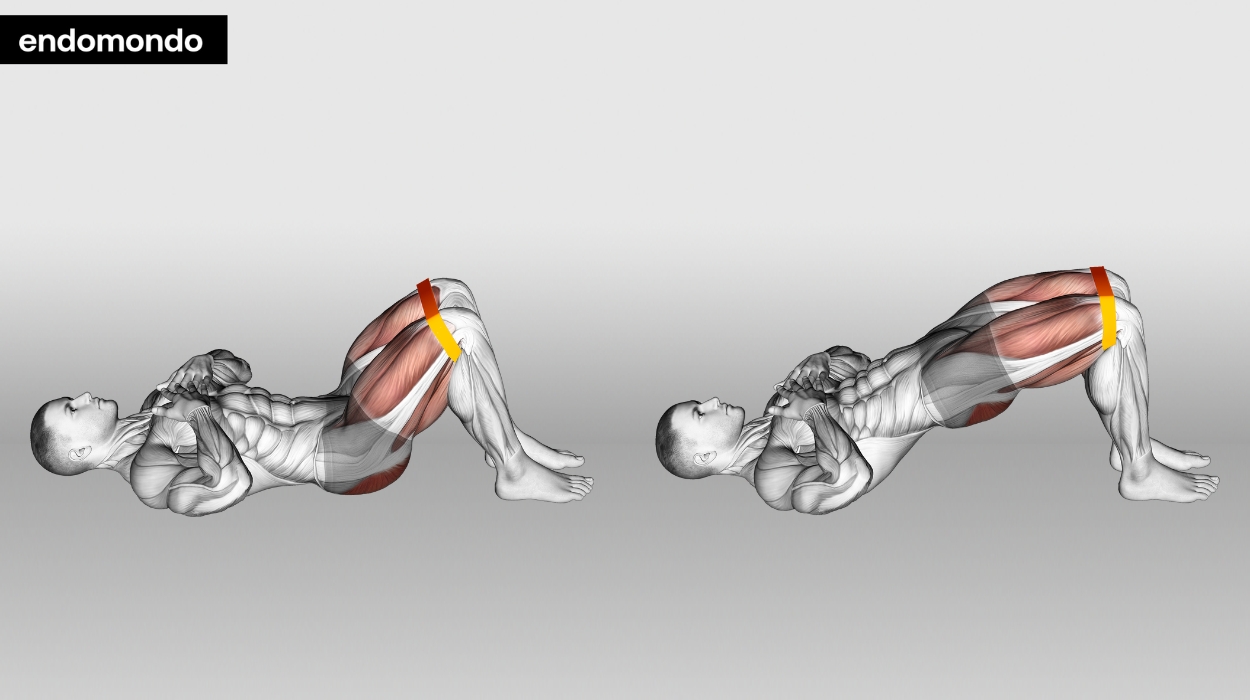
How to do:
- Lay down on the floor.
- Bend your knees and have heels as close to your butt. Then thrust your hips up and squeeze your buttocks.
- That will be your repetition (rep). Lower your butt to the floor.
- Try this exercise elevated with your upper back on a bench. Knees bent and feet on the floor. Lift your hips parallel with the bench, and then lower.
Tips:
- Ensure your shoulder blades are resting on the bench and your feet are planted firmly on the ground, with knees bent at a 90-degree angle.
- Drive through your heels, lifting your hips upwards while squeezing your glutes at the top, keeping your chin tucked to maintain spinal alignment.
- Avoid overextending at the top of the movement to prevent lower back strain; your body should form a straight line from shoulders to knees.
Optimal Sets and Reps: Perform three to four sets of 10-15 repetitions each.
Squats
This is an excellent exercise to work for different lower-body muscle groups. You can do this exercise without the weight if you are just starting. Use a barbell, free weights, or a resistance band.
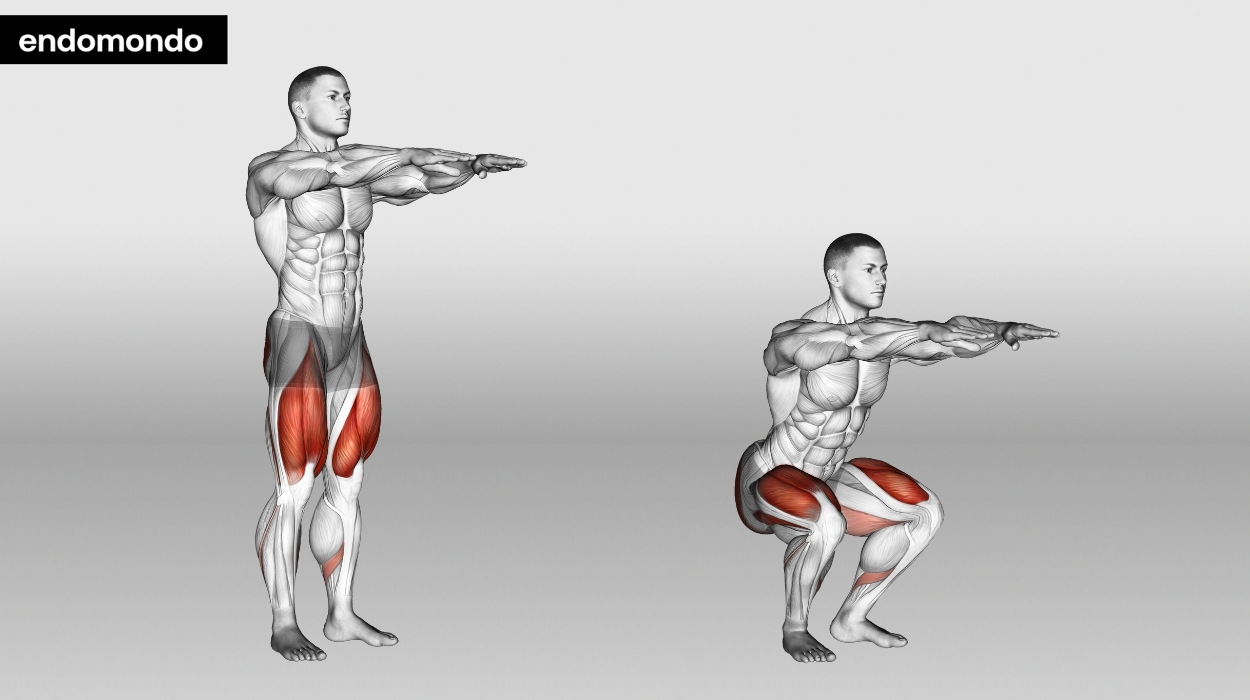
How to do:
- Stand up with legs hip-width apart.
- Lower your butt until your legs are around the height of your knees.
- Then rise.
Tips:
- Keep your feet shoulder-width apart and your toes slightly turned out for stability.
- Ensure your knees track over your toes and avoid collapsing inward as you lower into the squat.
- Maintain a straight back and engage your core throughout the movement, squatting down until your thighs are parallel to the floor.
Optimal Sets and Reps: Perform three to five sets of eight to 12 repetitions each.
Good Mornings
Doing this exercise can help strengthen and build your hamstrings and buttocks. It may also help with proper posture. Start without resistance. Once comfortable, add weight or a resistance band.
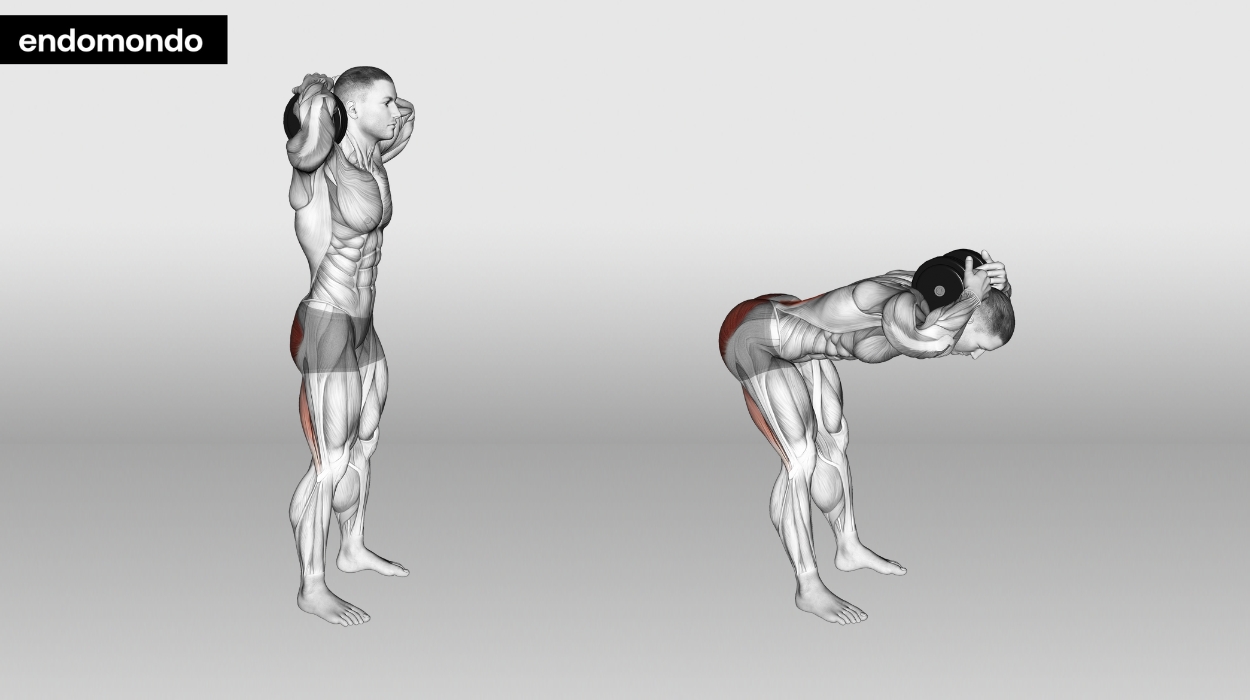
How to do:
- It is important to perform this exercise in good form. Stand with feet hip-width apart and place hands slightly behind your head.
- Keeping your back neutral, hinge at your hips until your torso is parallel to the floor.
- Hold for a second. Maintain your core tight.
- Then lift your torso keeping your back straight. That’s one rep.
Tips:
- Start with your feet hip-width apart, knees slightly bent, and maintain a flat back throughout the exercise to protect your spine.
- Hinge at the hips, not the waist, and lower your torso parallel to the floor, keeping the barbell securely on your shoulders.
- Keep your head in a neutral position aligned with your spine, and avoid rounding your back as you return to the starting position.
Optimal Sets and Reps: Perform three to four sets of eight to 10 repetitions each.
Lunges
This exercise can work the buttocks, calves, hips, and thigh muscles. You can start without any weights or resistance.
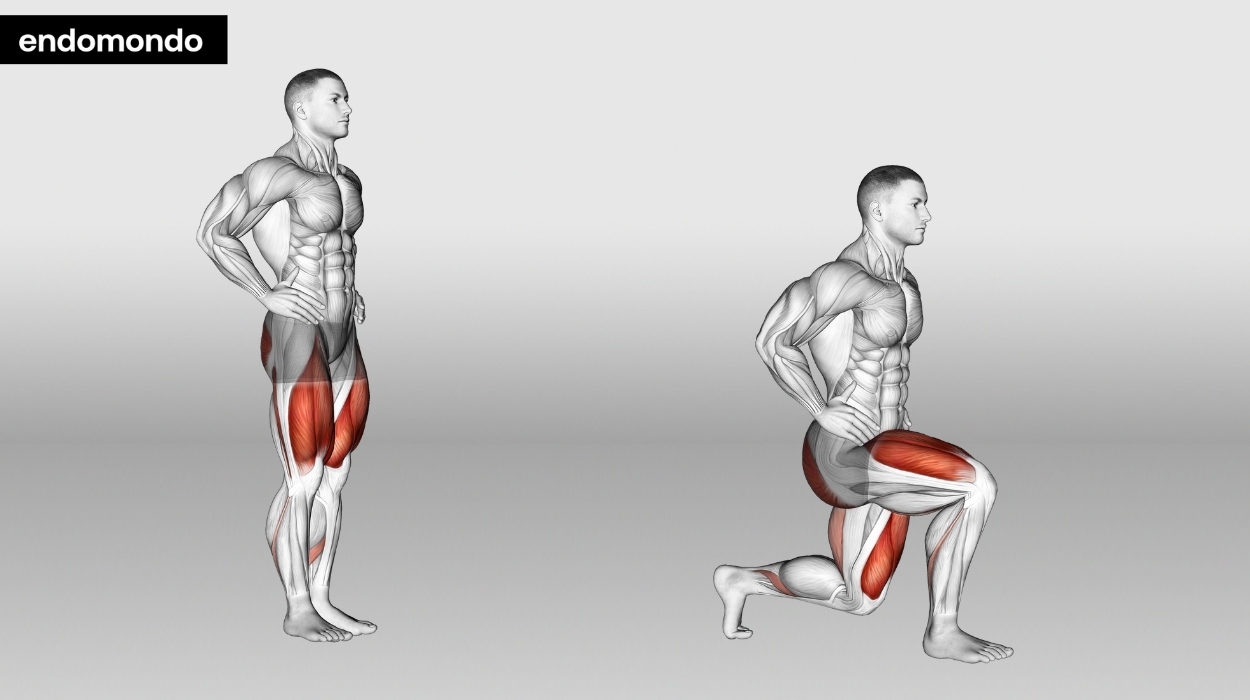
How to do:
- Stand with legs hip-width apart.
- Step one leg in front of you farther than your walking stride.
- Bend both legs, lowering your body, until the legs are at a 90-degree angle.
- Your front thigh should be parallel to the floor. Keep your chest up. Distribute your weight evenly on both legs for balance.
- Straighten your legs to lift.
- You can complete all repetitions in one leg and then change legs.
Tips:
- Step forward with one foot and lower your body until both knees are bent at about a 90-degree angle, ensuring your front knee does not go past your toes.
- Keep your upper body straight and core engaged, with your weight evenly distributed between both legs.
- Push back up to the starting position through the heel of your front foot, maintaining balance and control.
Optimal Sets and Reps: Perform three sets of 10-12 repetitions for each leg.
Donkey Kicks
These kicks will work directly on your butt muscles.
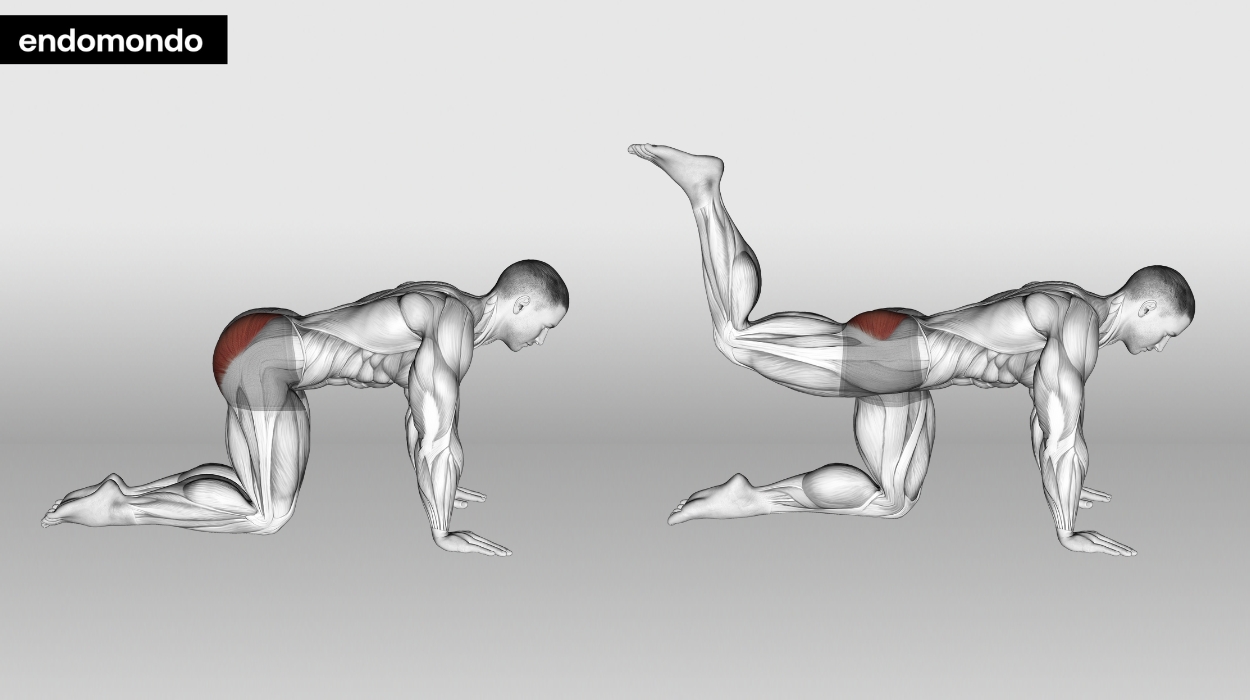
How to do:
- Lower yourself to the floor on all fours.
- Place your knees below your hips and arms straight below your shoulders.
- Keeping your core tight, lift one leg back bent at a 90-degree angle. Your foot should be lifted towards the ceiling.
- Lower your knee back to the floor to finish the rep. Repeat with the other leg. That is one rep.
Tips:
- Keep your back flat and core engaged to maintain proper alignment.
- Push your foot towards the ceiling as if you’re trying to stamp it, ensuring your hips remain level and square to the ground.
- Avoid arching your lower back as you lift your leg; the movement should be driven by your glutes, not your spine.
Optimal Sets and Reps: Perform three sets of 12-15 repetitions for each leg.
Can You Gain Weight In Butt?
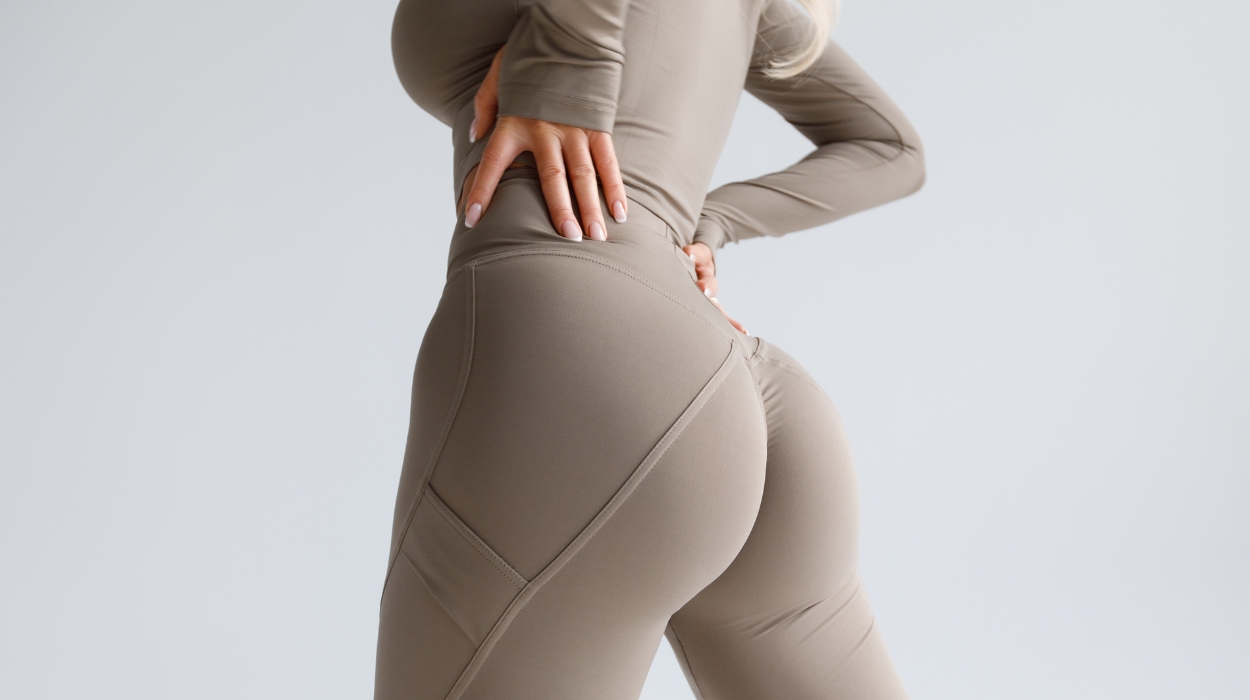
The short answer is yes. However, the weight you gain might not be fat tissue, you may gain muscle weight. When we start increasing calories, the excess energy not used is stored as fat. The way our bodies store fat is not targeted. We cannot choose where we gain body fat. This targeted gain can mainly be achieved by increasing muscle mass.
But how to gain weight in butt? The following tips will help you increase muscle growth and support weight gain.
Diet Changes For Gaining Butt Weight
Eat A Surplus Of Calories
To achieve an increase in weight, you need to increase the number of calories you would usually eat. Consider consuming 250-500 calories in excess to help with a gain of 0.5-1lb per week. This surplus of calories might help you gain weight in the buttocks and thighs, alongside a workout routine.
You can use this calorie estimator[1] to determine how many calories you need to consume daily.
Eat More Frequent Meals
It might be easier to include more calories if you eat more frequently. Secure three meals and high-calorie snacks in between.
Consider snacks high in protein like Greek yogurt, a handful of nuts, a cheese stick, or a glass of milk. Other options include nut butter with fruit or pairing fruit with nuts or cheese. This might help you easily achieve a calorie surplus.
Proteins
If you are working on increasing lean muscle mass, increasing your protein intake might be right for you. Our bodies can break down foods high in proteins into amino acids and then use them to build core muscles. It is recommended that people consume between 0.5-0.8 grams of protein per pound of body weight per day.
Eat A Variety Of Foods
Although there is an emphasis on making sure you eat enough protein, other food groups play a role in exercise performance and muscle growth.
Starches are a source of energy and will fuel your workouts. Choose whole grains or a high-fiber option whenever possible. Fiber keeps your gut healthy and moving. Options include potatoes, brown rice, whole-grain pasta, and whole-grain bread.
Including healthy fats in your balanced diet will boost calories but can also provide some essential fats like omega-3. Choose healthier fats like avocado, nuts, olive oil, and canola oil.
Last but not least, don’t forget fruits and vegetables. They are not only a good source of vitamins and minerals but also a multitude of health-protective agents. Fruits and vegetables are also sources of energy, fiber, and various nutrients. Assure of a variety of colors on your plate.
Recovery
When working on muscle building, rest is important. Make sure to get 8-10 hours of sleep every night. A study[2] showed how sleep loss negatively affected exercise performance. In addition, adequate rest will help with muscle recovery.
Consider supplementing with casein pre-sleep to support muscle recovery and building. A review article[3] recommended using at least 40-48 grams of casein 30 minutes before sleep to reduce inflammation and muscle soreness.
Hydration
Drink water whenever you are thirsty. Straw or lemonade color urine is what you should strive for as an indicator of proper hydration. Drink water primarily for hydration before, during, and after your workouts. If you work out for over two hours, consider including a sports drink to replenish electrolytes with hydration.
High Protein-Calorie Supplements
If you feel that eating more is not an option, you can consider supplementing with a protein shake. A protein supplement might help you receive more nutrients to increase muscle mass. Making protein shakes with additional sources of calories such as ground flax seeds, fruit, yogurt, or extra virgin olive oil will also boost energy intake.
There are alternatives to whey and casein supplements, like pea protein[4], which may be easier to digest and is vegan. Pea protein supplements which are combined with another complementary protein to get all nine of your essential amino acids will still provide plant-based protein and calories. Choose an alternative that fits your needs.
Foods That Make Your Butt Bigger
Include nutritious foods into your diet to help you achieve a bigger booty. These five foods are a must-have in your pantry to increase body weight.
Pinto Beans
One cup of pinto beans[5] has 11 grams of protein, 15 grams of fiber, and 245 calories. Beans are also low in the glycemic index. This edible seed or pulse is not only tasty and filling but versatile. And even though some recipes require added sugar, you can choose alternatives without.
Try a bean salad; this way, you can have a big bowl in the fridge and use it up during the week. You can also make rice and beans, or bean soup.
Chicken
Chicken is a staple food for people working on muscle building. It is a source of high-biological value protein. Around three and a half ounces of chicken breast[6] has 32 grams of protein. High biological value refers to having the right amount of amino acids in the correct proportions to meet bodily needs for building muscle and carrying out bodily functions.
Prepare it roasted, pan-roasted, or stewed. After it’s cooked, you can pair it up with starch and a vegetable of choice. You can also prepare rice dishes with salsa, beans, veggies, and cubed chicken.
Feel free to try turkey, but remove the skin to decrease the intake of saturated fats.
Brown Rice
This grain is packed with energy, fiber, and B vitamins to help with energy metabolism. One cup of brown rice[7] contains 218 calories, 5 grams of protein, and 3.5 grams of fiber. Brown rice contains antioxidants[8] that may protect the body from oxidative stress.
Rice is very versatile and filling. Season with herbs and spices to add aroma and flavor. It can be a part of a stir fry with vegetables and egg whites.
Beets
This nutrient-rich food is a low-calorie source of nitrates. Beets[9] have the potential to help improve the endurance of physical performance with increased blood flow. It is also a good source of manganese and copper to maintain bone health.
Beets may have less of a glycemic impact when boiled. They can also be roasted or grated fresh on top of a salad. You can be bold and include them in your smoothies.
Avocado
This fruit is a source of monounsaturated fats, which can help reduce the risk of heart disease. In addition, it is a source of fiber. Eating avocados can also boost healthy calories as one-fourth of an avocado[10] will add around 80 calories.
Add avocado as a side dish on your plate. Include it in your dishes, sandwiches, wraps, and salads. You can also include it in a fruit smoothie.
The Bottom Line
The butt is considered the powerhouse of the body. Genetics plays a big part in determining how much fat is stored in our lower body. With weight training and adequate nutrition, gaining weight in target areas is possible.
Consistency is a big part of achieving any goal. Gaining weight and strength in your butt and thighs may translate into safe activities of daily living. You should be successful in the end by setting a goal for building muscle in your butt and using butt workouts and essential nutrients as building blocks to reaching your goal.
+ 14 sources
Health Canal avoids using tertiary references. We have strict sourcing guidelines and rely on peer-reviewed studies, academic researches from medical associations and institutions. To ensure the accuracy of articles in Health Canal, you can read more about the editorial process here
- Nih.gov. (2023). Body Weight Planner – NIDDK. [online] Available at: https://www.niddk.nih.gov/bwp.
- Craven, J., McCartney, D., Desbrow, B., Surendran Sabapathy, Bellinger, P., Roberts, L.A. and Irwin, C. (2022). Effects of Acute Sleep Loss on Physical Performance: A Systematic and Meta-Analytical Review. [online] 52(11), pp.2669–2690. doi:https://doi.org/10.1007/s40279-022-01706-y.
- Kim, J.-Y. (2020). Pre-sleep casein protein ingestion: new paradigm in post-exercise recovery nutrition. [online] 24(2), pp.6–10. doi:https://doi.org/10.20463/pan.2020.0009.
- Salles, J., Guillet, C., Olivier Le Bacquer, Malnero-Fernandez, C., Christophe Giraudet, Véronique Patrac, Berry, A., Denis, P., Pouyet, C., Gueugneau, M., Yves Boirie, Jacobs, H. and Stéphane Walrand (2021). Pea Proteins Have Anabolic Effects Comparable to Milk Proteins on Whole Body Protein Retention and Muscle Protein Metabolism in Old Rats. [online] 13(12), pp.4234–4234. doi:https://doi.org/10.3390/nu13124234.
- Usda.gov. (2023). FoodData Central. [online] Available at: https://fdc.nal.usda.gov/fdc-app.html#/food-details/175200/nutrients.
- Usda.gov. (2023). FoodData Central. [online] Available at: https://fdc.nal.usda.gov/fdc-app.html#/food-details/331960/nutrients.
- Usda.gov. (2023). FoodData Central. [online] Available at: https://fdc.nal.usda.gov/fdc-app.html#/food-details/168875/nutrients.
- Gong, E., Shun Jing Luo, Li, T., Cheng Mei Liu, Guo Wen Zhang, Chen, J., Zi Cong Zeng and Rui Hai Liu (2017). Phytochemical profiles and antioxidant activity of brown rice varieties. [online] 227, pp.432–443. doi:https://doi.org/10.1016/j.foodchem.2017.01.093.
- McMahon, N., Leveritt, M. and Pavey, T. (2016). The Effect of Dietary Nitrate Supplementation on Endurance Exercise Performance in Healthy Adults: A Systematic Review and Meta-Analysis. [online] 47(4), pp.735–756. doi:https://doi.org/10.1007/s40279-016-0617-7.
- Usda.gov. (2023). FoodData Central. [online] Available at: https://fdc.nal.usda.gov/fdc-app.html#/food-details/171706/nutrients.



